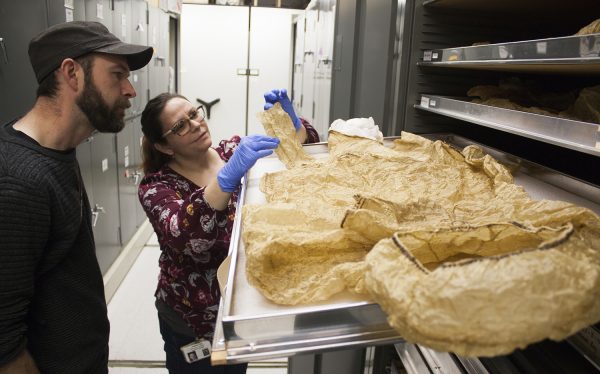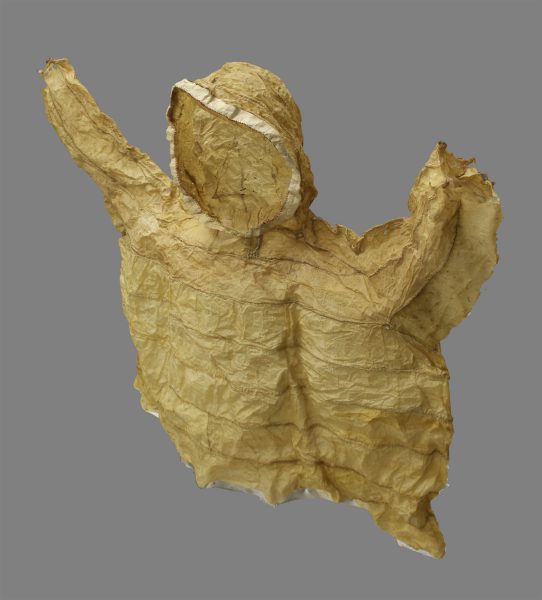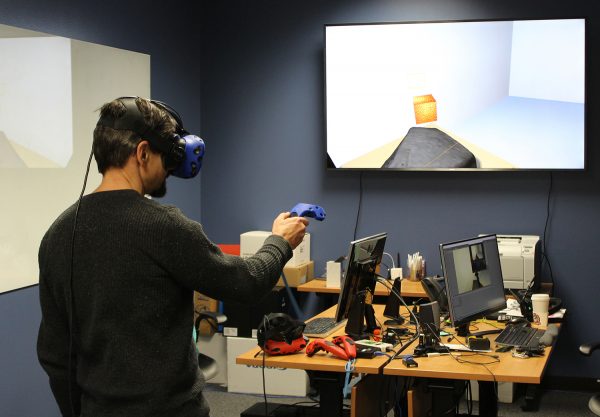Museum in a bottle: Virtual exhibit will display objects
December 5, 2018
Tom Moran
907-474-5581

Download text and photo captions here.
The newest wing of the University of Alaska Museum of the North will house pieces from across the museum’s vast collections. But it’ll fit into a pair of goggles.
Cassidy Phillips, a research technician at the University of Alaska Fairbanks, is building an exhibit in virtual reality, populated by carefully selected items from the real museum.
“The point of the project is to be able to provide access to people to experience some of the objects that are located in the basement of the museum that aren’t available for viewing upstairs,” he noted.
Phillips, with UAF's Alaska Established Program to Stimulate Competitive Research, said the project will ultimately contain at least 15 items that museum curators want to share with the public. Curators of archaeology, entomology, ornithology, botany, and ethnology and history came to an introductory meeting in November, where they tried out the VR setup and offered initial ideas for the selection and display of objects. Angela Linn, the museum’s senior collections manager of ethnology and history, said part of the project’s appeal is the opportunity to publicly share items that are too delicate for display.
“We’re here to preserve and share these objects, but every time you touch it, you run the risk of damaging it,” Linn said. “And so you’re constantly trying to find this balance between access and preservation.”

Phillips points to myriad other advantages of the virtual museum. Visitors will be able to scale objects up to examine even microscopic details. They may be able to see an “exploded” view of some items to better understand how their constituent parts connect and what their origins are. They’ll be able to adjust lighting to observe different textures and characteristics of objects, and potentially to access audio or video explaining pieces’ significance and characteristics. Visitors could also observe objects change over time.
“We could show a process of metamorphosis, or we could show the process of how an archaeology site gets covered with sediment, and then we can show how that sediment is removed to discover the artifact,” Phillips said.
Phillips said one key attribute of all the items selected is that they will bring together different aspects of the museum’s diverse collections. For example, he and Linn selected a child-sized parka made of seal gut as an initial entry, in part because the grass-stitched Yup’ik garment reflects elements of ethnology, mammalogy and botany.
“That’s the thing about a natural history museum that also includes cultural historic objects, art objects,” Linn said. “You get natural interdisciplinary, multidisciplinary conversations going, so that you don’t see this object as an isolated thing in and of itself; you inherently see those connections.”
The gut parka is also a case study of some of the other possibilities of the museum. Phillips said possible enhancements to the object in the virtual space might include interviews or videos demonstrating how such a parka is traditionally made, or a visualization of the region where the grass originated. Other possibilities could be virtual versions of the tools the Yupiit use to scrape seal intestines to make the parkas, or even enabling a viewer to inflate a seal intestine in virtual reality, mimicking a technique used to prepare the gut.
“We really want to try and show a process versus just static objects in a museum,” he said.

Phillips will construct virtual objects by taking numerous photos of each piece and using a program to drape the images onto a 3D mesh. While the exhibit will reach its fullest potential in VR, he said he also plans to make the items accessible in other formats, such as through the Google cardboard interface. The also might simply be 3D objects to explore and manipulate on a traditional computer monitor.
The project, supported by the National Science Foundation through Alaska EPSCoR, is scheduled to be completed by June.


